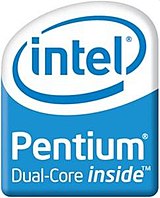Intel Pentium Dual-Core
| Pentium Dual-Core Central processing unit | |
| Produced: | From 2006 |
| Manufacturer: | Intel |
| CPU speeds: | 1.4 GHz to 2.2 GHz |
| FSB speeds: | 533 MT/s to 800 MT/s |
| Process: (MOSFET channel length) | 0.065 µm |
| Instruction set: | MMX, SSE, SSE2, SSE3, SSSE3, x86-64 |
| Microarchitecture: | Core Microarchitecture |
| Cores: | 2 (2x1) |
| Socket: | LGA 775, Socket M, Socket P |
The Pentium Dual-Core brand refers to lower-end x86-architecture microprocessors from Intel. They were based on either the 32-bit Yonah or 64-bit Allendale processors (with very different microarchitectures) targeted at mobile or desktop computers respectively.
In 2006, Intel announced a plan[1] to return the Pentium brand from retirement to the market, as a moniker of low-cost Core architecture processors based on single-core Conroe-L, but with 1 MB cache. The numbers for those planned Pentiums were similar to the numbers of the latter Pentium Dual-Core CPUs, but with the first digit "1", instead of "2", suggesting their single-core functionality. Apparently, a single-core Conroe-L with 1 MB cache was not strong enough to distinguish the planned Pentiums from other planned Celerons, so it was substituted by dual-core CPUs, bringing the "Dual-Core" add-on to the "Pentium" moniker.
The first processors using the brand appeared in notebook computers in early 2007. Those processors, named Pentium T2060, T2080, and T2130[2], had the 32-bit Pentium M-derived Yonah core, and closely resembled the Core Duo T2050 processor with the exception of having 1 MB L2 cache instead of 2 MB[3]. All three of them had a 533 MHz FSB connecting CPU with memory. "Intel developed the Pentium Dual-Core at the request of laptop manufacturers"[4].
Subsequently, on June 3, 2007, Intel released the desktop Pentium Dual-Core branded processors[5] known as the Pentium E2140 and E2160[6]. A E2180 model was released later in September 2007. These processors support the Intel64 extensions, being based on the newer, 64-bit Allendale core with Core microarchitecture. These closely resembled the Core 2 Duo E4300 processor with the exception of having 1 MB L2 cache instead of 2 MB[7]. Both of them had an 800 MHz FSB. They targeted the budget market above the Intel Celeron (Conroe-L single-core series) processors featuring only 512 kB of L2 cache. Such a step marked a change in the Pentium brand, relegating it to the budget segment rather than its former position as the mainstream/premium brand.
An article on Tom's Hardware claims that these CPUs are highly overclockable.
[edit] See also
[edit] References
- ^ http://www.dailytech.com/article.aspx?newsid=4252
- ^ Intel Pentium E2140 & E2160 review. TechSpot. Retrieved on 2007-06-23.
- ^ http://download.intel.com/design/mobile/datashts/31651902.pdf
- ^ http://asia.cnet.com/reviews/pcperipherals/0,39051168,61998152-8,00.htm
- ^ "Pentium E/Celeron 400 to be releasing on June 3", HKEPC Hardware. Retrieved on 2007-03-16.
- ^ Shilov, Anton. "Intel Readies Pentium E2000-Series Processors", X-bit labs. Retrieved on 2007-03-04.
- ^ Intel Pentium E2140 & E2160 review. TechSpot. Retrieved on 2007-06-23.
Intel Processor Numbers chart for Intel Pentium Dual-Core processors
| [hide] | |
|---|---|
| Discontinued | 4004 · 4040 · 8008 · 8080 · 8085 · iAPX 432 · i860 · i960 · 8086 · 8088 · 80186 · 80188 · 80286 · 80386 · 80486 · Pentium · Pentium Pro · Pentium II · Pentium III · Itanium · Pentium Extreme Edition · Pentium M · Pentium D · |
| Current | Pentium 4 · Core · Pentium Dual-Core · Core 2 · Celeron · A100 · Xeon · XScale · Itanium 2 |
| Lists | Intel CPU slots and sockets · Intel chipsets · Intel processors · Celeron · Core · Core 2 · Pentium 4 · Pentium D · Pentium Dual-Core · Pentium M · Xeon |
| Lists of Speculated | Celeron · Core 2 · Pentium Dual-Core · Xeon |
| Italics indicate non-x86 processors | |



1 Comments:
This comment has been removed by the author.
Post a Comment
Subscribe to Post Comments [Atom]
<< Home